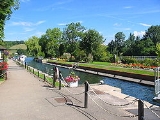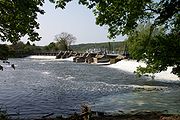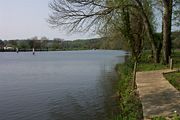
Mapledurham Lock
Encyclopedia
Mapledurham Lock is a lock
and weir
situated on the River Thames
in England
. The lock was first built in 1777 by the Thames Navigation Commissioners and the present lock dates from 1908.
Despite its name, the lock is located in the Berkshire
village and civil parish of Purley-On-Thames
on the south bank of the river, rather than in the Oxfordshire
village of Mapledurham
on the other side of the river. The weir stretches across the river, in both counties.
The weir runs from the lock island in a long curve across the river between the two villages. However no access is possible across the weir, and without a boat, journeys between the two villages require a lengthy detour via Reading
or Pangbourne
. The weir still provides a head of water to drive Mapledurham Watermill
which is on the opposite side of the river. The weir is also the furthest upstream on the Thames that has a salmon ladder
.
 Mapledurham mill dates back to Domesday Book
Mapledurham mill dates back to Domesday Book
, and the weir was probably connected to it then, although the earliest extant reference to the weir is from the time of Edward I
. The mill was attached to the property of Mapledurham House
, owned by the Blount family, who have always had an interest in the weir. There was a flash lock
at the weir but passage through this was stopped at the opening of the pound lock in 1777. The lock was built of fir on the Purley side of the river and was to be called Purley Lock. However local custom retained the old name. A cottage was ordered for the lock-keeper in 1816. During the 19th century there were disputes between the lock-keeper William Sheppard and the Blount family. However despite Blount's representations to the Conservators, Sheppard remained in post for 54 years, retiring at the age of 79. A new and greatly enlarged lock was built beside the old one in 1908.
Mapledurham Mill is still functioning across the river from the lock, making this the only lock and weir combination on the Thames that supports the two functions that were originally the norm on river navigations. As both mill and navigation are now principally tourist enterprises, this no longer leads to the sort of conflicts between milling and navigation interests that were once common on the river.
 The river is in open country nearly all the way to Pangbourne
The river is in open country nearly all the way to Pangbourne
and has been described by Robert Gibbings
writing in 1939 (Sweet Thames Run Softly) as so crowded with views "they might have dropped from the gold frames of the Royal Academy
".
After Mapledurham, Hardwick House
is visible on the northern side of the river. Pangbourne Meadows, owned by the National Trust, lie to the south of the river before Whitchurch Bridge
. This toll bridge crosses the river between Pangbourne and Whitchurch
. Between the bridge and Whitchurch Lock, the River Pang
joins the Thames from the south.
The Thames Path
follows the southern bank to Whitchurch Bridge, where it crosses the river. (Although this is a toll bridge, pedestrians are no longer charged).
made many drawings in this area, and Toad Hall is said to be based on either Mapledurham House
or Hardwick House
, home of Charles Day Rose
, nearby.
Lock (water transport)
A lock is a device for raising and lowering boats between stretches of water of different levels on river and canal waterways. The distinguishing feature of a lock is a fixed chamber in which the water level can be varied; whereas in a caisson lock, a boat lift, or on a canal inclined plane, it is...
and weir
Weir
A weir is a small overflow dam used to alter the flow characteristics of a river or stream. In most cases weirs take the form of a barrier across the river that causes water to pool behind the structure , but allows water to flow over the top...
situated on the River Thames
River Thames
The River Thames flows through southern England. It is the longest river entirely in England and the second longest in the United Kingdom. While it is best known because its lower reaches flow through central London, the river flows alongside several other towns and cities, including Oxford,...
in England
England
England is a country that is part of the United Kingdom. It shares land borders with Scotland to the north and Wales to the west; the Irish Sea is to the north west, the Celtic Sea to the south west, with the North Sea to the east and the English Channel to the south separating it from continental...
. The lock was first built in 1777 by the Thames Navigation Commissioners and the present lock dates from 1908.
Despite its name, the lock is located in the Berkshire
Berkshire
Berkshire is a historic county in the South of England. It is also often referred to as the Royal County of Berkshire because of the presence of the royal residence of Windsor Castle in the county; this usage, which dates to the 19th century at least, was recognised by the Queen in 1957, and...
village and civil parish of Purley-On-Thames
Purley-on-Thames
Purley on Thames or simply Purley, is a village and civil parish in Berkshire, England. It forms part of the Reading urban area, but remains outside the borough, in West Berkshire. The village is situated about north-west of Reading, and east of Pangbourne...
on the south bank of the river, rather than in the Oxfordshire
Oxfordshire
Oxfordshire is a county in the South East region of England, bordering on Warwickshire and Northamptonshire , Buckinghamshire , Berkshire , Wiltshire and Gloucestershire ....
village of Mapledurham
Mapledurham
Mapledurham is a small village, civil parish and country estate beside the River Thames in Oxfordshire.It should not be confused with the Mapledurham electoral ward of the nearby Borough of Reading, which is a subdivision of that town's suburb of Caversham....
on the other side of the river. The weir stretches across the river, in both counties.
The weir runs from the lock island in a long curve across the river between the two villages. However no access is possible across the weir, and without a boat, journeys between the two villages require a lengthy detour via Reading
Reading, Berkshire
Reading is a large town and unitary authority area in England. It is located in the Thames Valley at the confluence of the River Thames and River Kennet, and on both the Great Western Main Line railway and the M4 motorway, some west of London....
or Pangbourne
Pangbourne
Pangbourne is a large village and civil parish on the River Thames in the English county of Berkshire. Pangbourne is the home of the independent school, Pangbourne College.-Location:...
. The weir still provides a head of water to drive Mapledurham Watermill
Mapledurham Watermill
Mapledurham Watermill is a historic watermill in the civil parish of Mapledurham in the English county of Oxfordshire. The mill is driven by the head of water created by Mapledurham Lock and Weir and is preserved in an operational state.- History :...
which is on the opposite side of the river. The weir is also the furthest upstream on the Thames that has a salmon ladder
Fish ladder
A fish ladder, also known as a fishway, fish pass or fish steps, is a structure on or around artificial barriers to facilitate diadromous fishes' natural migration. Most fishways enable fish to pass around the barriers by swimming and leaping up a series of relatively low steps into the waters on...
.
History

Domesday Book
Domesday Book , now held at The National Archives, Kew, Richmond upon Thames in South West London, is the record of the great survey of much of England and parts of Wales completed in 1086...
, and the weir was probably connected to it then, although the earliest extant reference to the weir is from the time of Edward I
Edward I of England
Edward I , also known as Edward Longshanks and the Hammer of the Scots, was King of England from 1272 to 1307. The first son of Henry III, Edward was involved early in the political intrigues of his father's reign, which included an outright rebellion by the English barons...
. The mill was attached to the property of Mapledurham House
Mapledurham House
Mapledurham House is an Elizabethan stately home located in the civil parish of Mapledurham in the English county of Oxfordshire.-History and architecture:...
, owned by the Blount family, who have always had an interest in the weir. There was a flash lock
Flash lock
Early locks were designed with a single gate, known as a flash lock or staunch lock. The earliest European references to what were clearly flash locks were in Roman times....
at the weir but passage through this was stopped at the opening of the pound lock in 1777. The lock was built of fir on the Purley side of the river and was to be called Purley Lock. However local custom retained the old name. A cottage was ordered for the lock-keeper in 1816. During the 19th century there were disputes between the lock-keeper William Sheppard and the Blount family. However despite Blount's representations to the Conservators, Sheppard remained in post for 54 years, retiring at the age of 79. A new and greatly enlarged lock was built beside the old one in 1908.
Mapledurham Mill is still functioning across the river from the lock, making this the only lock and weir combination on the Thames that supports the two functions that were originally the norm on river navigations. As both mill and navigation are now principally tourist enterprises, this no longer leads to the sort of conflicts between milling and navigation interests that were once common on the river.
Access to the lock
The lock is accessible from Purley, by going down Mapledurham Drive, a metalled lane that turns to gravel.Reach above the lock

Pangbourne
Pangbourne is a large village and civil parish on the River Thames in the English county of Berkshire. Pangbourne is the home of the independent school, Pangbourne College.-Location:...
and has been described by Robert Gibbings
Robert Gibbings
Robert Gibbings was an Irish artist and author who was most noted for his work as a wood carver and engraver and for his books on travel and natural history.-Life:...
writing in 1939 (Sweet Thames Run Softly) as so crowded with views "they might have dropped from the gold frames of the Royal Academy
Royal Academy
The Royal Academy of Arts is an art institution based in Burlington House on Piccadilly, London. The Royal Academy of Arts has a unique position in being an independent, privately funded institution led by eminent artists and architects whose purpose is to promote the creation, enjoyment and...
".
After Mapledurham, Hardwick House
Hardwick House
Hardwick House is a Tudor-style house on the banks of the River Thames on a slight rise at Whitchurch-on-Thames in the English county of Oxfordshire. It is reputed to have been the inspiration for E. H...
is visible on the northern side of the river. Pangbourne Meadows, owned by the National Trust, lie to the south of the river before Whitchurch Bridge
Whitchurch Bridge
Whitchurch Bridge is a toll road bridge over the River Thames in England. It carries the road between the villages of Pangbourne, Berkshire, and Whitchurch-on-Thames, Oxfordshire, and crosses the river on the reach above Mapledurham Lock, just before Whitchurch Lock...
. This toll bridge crosses the river between Pangbourne and Whitchurch
Whitchurch-on-Thames
Whitchurch-on-Thames is a village and civil parish on the Oxfordshire bank of the River Thames, about northwest of Reading, Berkshire. Opposite Whitchurch on the Berkshire bank is the village of Pangbourne.-History:...
. Between the bridge and Whitchurch Lock, the River Pang
River Pang
The River Pang is a small chalk stream river in the west of the English county of Berkshire, and a tributary of the River Thames. It runs for approximately from its source near the village of Compton to its confluence with the Thames in the village of Pangbourne.The river, and its water voles, are...
joins the Thames from the south.
The Thames Path
Thames Path
The Thames Path is a National Trail, opened in 1996, following the length of the River Thames from its source near Kemble in Gloucestershire to the Thames Barrier at Charlton. It is about long....
follows the southern bank to Whitchurch Bridge, where it crosses the river. (Although this is a toll bridge, pedestrians are no longer charged).
Literature and the Media
The artist E. H. Shepherd who illustrated The Wind in the WillowsThe Wind in the Willows
The Wind in the Willows is a classic of children's literature by Kenneth Grahame, first published in 1908. Alternately slow moving and fast paced, it focuses on four anthropomorphised animal characters in a pastoral version of England...
made many drawings in this area, and Toad Hall is said to be based on either Mapledurham House
Mapledurham House
Mapledurham House is an Elizabethan stately home located in the civil parish of Mapledurham in the English county of Oxfordshire.-History and architecture:...
or Hardwick House
Hardwick House
Hardwick House is a Tudor-style house on the banks of the River Thames on a slight rise at Whitchurch-on-Thames in the English county of Oxfordshire. It is reputed to have been the inspiration for E. H...
, home of Charles Day Rose
Charles Day Rose
Sir Charles Day Rose, 1st Baronet was a British-Canadian businessman, race horse breeder, yachtsman and Liberal politician.Born in Montreal, he was the second son of Sir John Rose, 1st Baronet...
, nearby.

